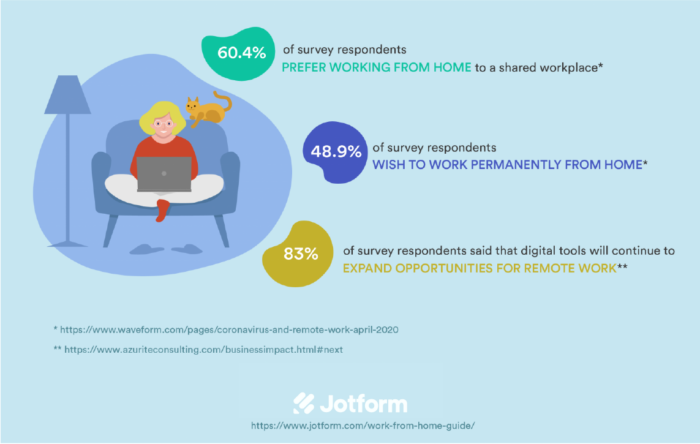In the midst of the COVID-19 pandemic, many employers across the U.S. started asking their employees to work from home. Now, employers and employees alike are wondering whether pre-pandemic office life will ever return.
You may be able to find that answer in the data that tells the COVID-19 story. We asked business owners and digital media insiders to help us comb through the numerous work-from-home stats that are emerging after months of stay-at-home orders and mandatory remote collaboration. Here are five statistics that help explain how Americans are working from home — and whether the company workplace as we know it is already a thing of the past.
- 60.4 percent of survey respondents working from home during COVID-19 physical distancing orders said they prefer the arrangement to a shared workplace.
- 48.9 percent of those survey respondents said they wish working from home could be “a permanent change.”
- Prior to the pandemic, 43 percent of workers spent at least some time working remotely, and 31 percent of those employees worked from home 80 to 100 percent of the time.
- Also pre-pandemic, 83 percent of survey respondents globally said that “the ability to work flexibly at least some of the time” was a deciding factor when choosing between two jobs.
- 85 percent of the business leaders who responded to one survey said that digital tools will continue to expand opportunities for remote work.
Given all the headlines about remote work, this figure is actually smaller than you might expect. Still, with the majority of newly decentralized employees preferring “the flexibility of working alone in the comfort of their own homes…productivity can be boosted in an online office setup,” says Willie Greer, founder of The Product Analyst.
Again, this figure — just under half of the respondents — reflects some ambivalence about the future of traditional offices. “While there are a good number of employees enjoying their work-from-home jobs, many see it as temporary to address the challenges of this pandemic,” says Greer.
This figure supports the notion that COVID-19 closures just accelerated an already-growing trend. “For employers who think this is a temporary phenomenon, this data shows a rising number compared to previous years and a large segment of the workforce,” says Rex Freiberger, CEO of Superlativ.io and GadgetReview.
Most employees want the option to work from home, and that preference predates the widespread move toward remote employment associated with the pandemic. Employers and human resources departments should take note, says Frieberger. “Employees value flexibility, and if you aren’t offering it, you’ll lose out on top talent,” he says.
Employers may worry about productivity loss associated with a remote workforce. But the Azurite survey of 3,500 business decision-makers in the U.S. showed that most managers and employees say they work just as productively at home as at the office — and digital tools are the key to that success.
Of course, many jobs cannot be done remotely. Healthcare providers, manufacturers, frontline retail staff, and others don’t have the option to work from home. For traditional office workers, though — particularly those in the tech industry — statistics like these suggest that widespread remote work is here to stay.
“As Joan Burke, chief people officer of Docusign, told The New York Times in May 2020, “Working from home is a great thing for the company and for the employees, who don’t want to get back in cars and commute for two hours. That’s lost productivity. I see it happening way more often in the future.” Work-from-home stats, like those listed above, seem to back up Burke’s prediction.


























Send Comment: